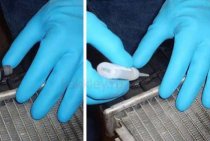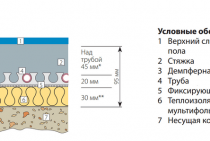Features and characteristics of the material
Gypsum has long been used to equip various models of false fireplaces. The material is characterized by sufficient strength, ductility and reasonable cost. To create gypsum mixtures, natural materials of natural origin are used, which do not pose a danger to the human body.
 Gypsum false fireplace
Gypsum false fireplace
In addition, gypsum has certain advantages:
- the material is refractory, which makes it possible to use it in the construction of classic fireplaces with real fire;
- gypsum is also suitable for electric fireplaces, because it does not conduct electricity;
- time does not affect the volume of plaster figures;
- the material is plastic, helping to create the most complex shapes;
- it is possible to create elements from gypsum at home.
A curious feature of gypsum is that in a humid room it absorbs water into itself, and in a dry room it gives it away. It turns out that the untreated surface of this material affects the level of humidity in the room, making it suitable for human life.
But here it should be noted that under constant damp conditions, gypsum begins to darken, and long-term storage of the raw material gives it a yellowish tint. In addition, gypsum is fragile, serious mechanical effects are contraindicated for it, the material requires care in handling.
Hardened gypsum is often used in the construction of fireplaces with real fire. Most often, stucco molding of various forms is used as a fireplace decoration, suitable for both classical and modern styles. Such a fireplace will look great.
At the same time, it should be noted that for a decorative gypsum fireplace there are many possibilities in terms of decoration. Gypsum surface is easy to paint with water-based paint, apply artistic painting. If you have initial artistic skills, such work can be done independently.
The basis of a do-it-yourself gypsum fireplace is the overall design of the required dimensions. The gypsum fireplace portal is made according to two technological options:
- in the first case, a frame is erected, on which all the necessary elements are strengthened;
- the second option involves the complex creation of a full-fledged structure, which is one whole.
For obvious reasons, the second option is much more expensive, does not need modifications, and has excellent external data.
Self-design of a plaster portal
 Do-it-yourself gypsum elements
Do-it-yourself gypsum elements
Let's try to figure out how to make a gypsum fireplace with your own hands.
To make the fireplace look beautiful, it is recommended to approach the design work with full responsibility, because the beauty of the whole structure will depend on this.
You can copy the sculptures you like most using plaster elements, and then the whole structure will look unusual and delightful. To create harmony in the interior, it is recommended to copy certain patterns from furniture or fabrics. This is done quite simply, because gypsum is a plastic and easy-to-use material.
If you have creative skills, you can easily mold various shapes or patterns from plaster. Note that beginners should not be upset, because the store sells any plaster decor elements. In addition, you can always order exclusive jewelry in the workshop.
Solution preparation
Anyone who wants to try their hand at working with gypsum material is advised to learn how to knead a suitable mortar mixture.Based on what kind of stucco molding you need to decorate the fireplace, mixes of various consistencies are prepared:
- for a thick mass you will need one kilogram of gypsum and water in an amount of 500 ml;
- the density of the average level is achieved by increasing the volume of water to 600 - 700 ml per 1 kg of material;
- a liquid state is obtained by mixing a share of gypsum in 800 - 900 ml of water.
If you need to create a large figure, then there is no need to knead a large amount of mortar - its construction is carried out in separate parts. For thin elements, a liquid solution is used that easily fills depressions and voids.
Choice of decorative elements
Now let's look at how high-quality modeling is performed.
Before applying the gypsum mortar to the portal, it is necessary to draw the contours of future patterns on its surface. To make the process easy, it is recommended to use stencils to get a clear symmetry.
Plaster molding
Now you can prepare a solution of the required consistency and evenly apply it to the portal, rubbing from all sides.
According to the applied drawings, patterns, depressions and elevations are formed, the remaining mixture is removed. After the plaster is completely dry, the patterns are sanded using sandpaper.
If you wish to strengthen decorative elements of complex shapes on the portal, they will have to be made separately. Such gypsum stucco molding will be the subject of your pride.
The subtleties of decoration
During the manufacture of elements for decoration, it is recommended to use the advice of experienced craftsmen:
to create the necessary element, a form is first prepared into which the gypsum mixture will be poured. Complex structures are made of plasticine, on the surface of which the first layer of gypsum mortar is applied with a brush;
immediately before work, the molds are treated with a solution of ordinary soap so that the process of extracting the finished element does not cause difficulties;
gypsum mortar is poured in several stages, each of which involves a layer no more than one centimeter thick. The next filling is performed after the previous one is completely dry.
In the process of work, it is necessary to ensure that no air bubbles remain, which can be removed by simply shaking the molds;
hardened products are carefully removed from the molds and polished. In order for the drying process to take place qualitatively, the forms with figured products are placed in an oven, in which a temperature regime is created from one hundred and sixty degrees Celsius
A fan, a battery and a hair dryer are not used, because during drying they can cause deformation of products;
at the final stage, do-it-yourself stucco molding is glued to the surface using a special adhesive composition for this.
Creating stucco is a very exciting and interesting process, but quite complicated. At the working stages, there will certainly be difficulties in mixing the mortar mixture of the required consistency, symmetry in the patterns will be given quite difficult. But each resulting ornament will be 100% individual, it will be an excellent option for decorating the interior.


